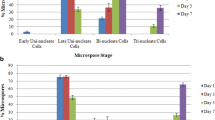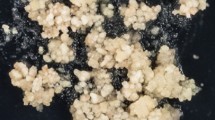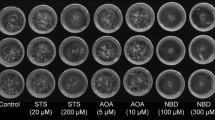Abstract
Prior to this report, heat treatment (32.5°C, 24 h) was the method used to induce embryogenesis fromBrassica napus microspores. Continuous culture at 25°C results in pollen development. This study shows that colchicine alone, at the non-inductive temperature of 25°C, can induce embryogenesis, thus demonstrating that heat shock is not required for embryogenic induction inB. napus cv. Topas. Embryogenic frequencies of over 15% were obtained by culturing isolated microspores with 25 μM colchicine for 42 h at 25°C. The microspore developmental stages responsive to colchicine were unicellular vacuolate and late unicellular, somewhat earlier stages than the population responsive to heat induction. Other groups have reported that heat-shock proteins are essential to the induction of embryogenesis. The present study offers a method of embryogenic induction without the use of heat which will allow discrimination between the factors associated with response to heat shock and those involved with changing cell development.
Similar content being viewed by others
Abbreviations
- LU:
-
Late-unicellular
- PPB:
-
Preprophase band
- UV:
-
unicellular-vacuolate
References
Carpenter JL, Ploense SE, Snustad DP, Silflow CD (1992) Preferential expression of an α-tubulin gene ofArabidopsis in pollen. Plant Cell 4: 557–571
Chen JL, Beversdorf WD (1992) Production of spontaneous diploid lines from isolated microspores following cryopreservation in spring rapeseed (Brassica napus L.). Plant Breeding 108: 324–327
Chen ZZ, Snyder Z, Fan ZG, Loh WH (1994) Efficient production of doubled haploid plants through chromosome doubling of isolated microspores inBrassica napus. Plant Breeding 113:217–221
Chuong PV, Beversdorf WD (1985) High frequency embryogenesis through isolated microspore culture inBrassica napus L. andB. carinata Braun. Plant Sci 39: 219–226
Cleveland DW, Pittenger MF, Feramisco JR (1983) Elevation of tubulin levels by microinjection suppresses new tubulin synthesis. Nature 305: 738–740
Cordewener JHG, Busink R, Traas JA, Custers JBM, Dons HJM, Van Lookeren Campagne MM (1994) Induction of microspore embryogenesis inBrassica napus L. is accompanied by specific changes in protein synthesis. Planta 195: 50–56
Fan Z, Armstrong KC, Keller WA (1988) Development of microspores in vivo and in vitro inBrassica napus L. Protoplasma 147: 191–199
Gamborg OL (1982) Callus and cell culture. In: Wetter LR, Constabel F (eds) Plant tissue culture methods. National Research Council of Canada, Prairie Regional Laboratory, Saskatoon, Saskatchewan NRCC 19876
Gland A, Lichter R, Schweiger HG (1988) Genetic and exogenous factors affecting embryogenesis in isolated microspore cultures ofBrassica napus L. J Plant Physiol 132: 613–617
Gunning BES, Hardham AR (1982) Microtubules. Annu Rev Plant Physiol 33: 651–698
Heslop-Harrison J (1968) Synchronous pollen mitosis and the formation of the generative cell in massulate orchids. J Cell Sci 3: 457–466
Iqbal MCM, Mollers C, Robbelen G (1994) Increased embryogenesis after colchicine treatment of microspore cultures ofBrassica napus L. J Plant Physiol 143: 222–226
Keller WA, Armstrong KC (1978) High frequency production of microspore-derived plants fromBrassica napus anther culture. Z. Pflanzenzucht 80: 100–108
Keller WA, Arnison PG, Cardy BJ (1986) Haploids from gametophytic cells — recent developments and future prospects. In: Green CE, Somers DA, Hackett WP, Biesboer DD (eds) Plant tissue and cell culture (Proc 6th Int Tissue Culture Congr.) Alan R Liss Inc., New York, pp 223–241
Kott LS, Polsoni L, Beversdorf WD (1988) Cytological aspects of isolated microspore culture ofB. napus. Can J Bot 66:1658–1664
Lichter R (1981) Anther culture ofBrassica napus in a liquid medium. Z Pflanzenphysiol 103: 229–237
Mineyuki Y, Gunning BES (1990) A role for preprophase bands of microtubules in maturation of new cell walls, and a general proposal on the function of preprophase band sites in cell division in higher plants. J Cell Sci 97: 527–537
Pechan PM, Keller WA (1989) Induction of microspore embryogenesis inBrassica napus L. by gamma irradiation and ethanol stress. In Vitro Cell Dev Biol 25: 1073–1075
Pechan PM, Bartels D, Brown DCW, Schell J (1991) Messenger-RNA and protein changes associated with induction ofBrassica napus embryogenesis. Planta 184: 161–165
Simmonds DH (1986) Prophase bands of microtubules occur in protoplast cultures ofVicia hajastana Grossh. Planta 167:469–472
Simmonds DH (1994) Mechanism of induction of microspore embryogenesis inBrassica napus: significance of the preprophase band of microtubules in the first sporophytic division. In: Akkas N (ed) Biomechanics of active movement and division of cells (NATO ASI series). Springer-Verlag, Berlin, pp 569–574
Simmonds DH, Gervais C, Keller WA (1991) Embryogenesis from microspores of embryogenic and non embryogenic lines ofBrassica napus. In: McGregor DI (ed) Proceedings GCIRC 8th International Rapeseed Congress. Saskatoon, Sask, Canada pp 306–311
Srivastava PS, Johri BM (1988) Pollen embryogenesis. J Palynology 23: 83–99
Sternlicht H, Ringel I, Szasz J (1983) Theory for modelling the copolymerization of tubulin and tubulin-colchicine complex. Biophys J 42: 255–267
Swanson EB, Herrgesell MJ, Arnoldo M, Sippell DW, Wong RSC (1989) Microspore mutagenesis and selection: Canola plants with field tolerance to the imidazolinones. Theor Appl Genet 78: 525–530
Telmer CA, Newcomb W, Simmonds DH (1995) Cellular changes during heat shock induction and embryo development of cultured microspores ofBrassica napus cv. Topas. Protoplasma 185: 106–112
Telmer CA, Newcomb W, Simmonds DH (1993) Microspore development inBrassica napus and the effect of high temperature on division in vivo and in vitro. Protoplasma 172: 154–165
Telmer CA, Simmonds DH, Newcomb W (1992) Determination of developmental stage to obtain high frequencies of embryogenic microspores inBrassica napus. Physiol Plant 84: 417–424
Vierling E (1991) The roles of heat shock proteins in plants. Annu Rev Plant Physiol Plant Mol Biol 42: 579–620
Zaki MAM, Dickinson HG (1995) Modification of cell development in vitro: The effect of colchicine on anther and isolated microspore culture inBrassica napus. Plant Cell Tissue Organ Culture 40: 255–270
Zhao J-P, Simmonds DH (1995) Application of trifluralin to embryogenic microspores to generate doubled haploid plants inBrassica napus. Physiol Plant, in Press
Zhao J-P, Simmonds DH, Newcomb W (1996) High frequency production of doubled haploid plants ofBrassica napus cv. Topas derived from colchicine-induced embryogenesis without heat shock. Plant Cell Reports (in press)
Author information
Authors and Affiliations
Additional information
The authors wish to thank C. Bornman for his interest and encouragement. We gratefully acknowledge support from the School of Graduate Studies and Research, Queen's University to J.-P. Z., from Hilleshog AB, Sweden to D.H.S., and from the Natural Sciences and Engineering Research Council of Canada to D.H.S. and W.N. Plant Research Centre contribution No. 1595.
Rights and permissions
About this article
Cite this article
Zhao, JP., Simmonds, D.H. & Newcomb, W. Induction of embryogenesis with colchicine instead of heat in microspores ofBrassica napus L. cv. Topas. Planta 198, 433–439 (1996). https://doi.org/10.1007/BF00620060
Received:
Accepted:
Issue Date:
DOI: https://doi.org/10.1007/BF00620060




